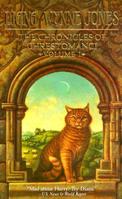
| Series: | Chrestomanci #1 |
| Publisher: | HarperTrophy |
| Copyright: | 1977 |
| Printing: | 2001 |
| ISBN: | 0-06-447268-X |
| Format: | Mass market |
| Pages: | 263 |
I read this book as part of The Chronicles of Chrestomanci Volume I omnibus, which is the book reflected in the sidebar information.
Cat Chant is, in the grand tradition of books of this sort, an orphan. Unlike most of these books, however, he has a surviving elder sister, Gwendolen, to whom he is deeply devoted. Gwendolen is the one who's a witch; Cat has no apparent magic ability whatsoever. They live together with a foster mother in a neighborhood of people with minor magical talent until they discover, among their parents' possessions, three letters from a person named Chrestomanci. Cat isn't told just who Chrestomanci is, but he's clearly someone incredibly important. Using the letters as justification, Gwendolen contacts Chrestomanci, and when they both are invited to live with Chrestomanci as part of his household, the obvious assumption is that it's because of her magical ability and their good family name.
That's the opening of a fast-moving and twisty young-adult tale about a world with widespread magic and an unusual magical governance structure. It reads, at times, very much like a boarding school story, and I can see the reason for the renewed marketing of this series after Harry Potter became a phenomenon. (I think it's rather more interesting, and rather less annoying, than Harry Potter, but then I have an unusually poor opinion of that series.) Gwendolen, by the time they reach Chrestomanci's household, has a ridiculously high opinion of herself and starts feuds with both Chrestomanci's own children and Chrestomanci himself. Cat, meanwhile, is torn between his deep loyalty to his sister and his natural tendency to be decent to everyone, which eventually translates into a growing attraction to the strange household in which he finds himself.
This is one of those books in which the plot is driven partly by characters withholding vital information from each other, but it's one of the better-handled and better-justified versions of that I've seen. I normally hate that plot construction, but here, while I found it annoying in places, I think it mostly worked. The downside is that the reader is likely to get quite frustrated with the adults and their refusal to explain or to do anything about obvious problems; the upside is that the startling finale gains a lot of emotional weight and is able to turn the story inside-out. There's a lot of stressful childish nastiness in the middle, and I think I could have done without some of that, but it does build a lot of reader sympathy for Cat.
I think two things make this book: Chrestomanci and the world building. Chrestomanci himself is a great character, particularly for a young adult novel and when seen through the eyes of a young protagonist. He avoids being the typical adult mentor figure, and his air of bemused abstraction creates a lot of interesting layers and realizations through the story. It builds an aura of both ability and distance that's unlike the normal mentor figure. The world background at first seems a touch silly, but it gains depth through small touches and consistent detail. The magic system is neither numinous nor RPG-detailed and can seem a bit flippant — comparisons with Harry Potter work here as well — but it hangs together well and is serious enough to support some moments of real awe and fear.
This is an occasionally frustrating book, but it's still a fun, light read, with good pacing. Recommended if you're looking for a light take on magical schools, particularly if you're looking for something akin to Harry Potter.
Followed by The Magicians of Caprona, although the omnibus that I read packages it with The Lives of Christopher Chant, the fourth book of the series in publication order.
Reviewed: 2011-04-24